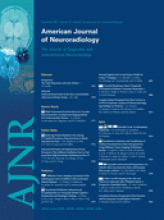Abstract
BACKGROUND AND PURPOSE: The decision as to the treatment of incidental IAs is complex. There are no certain quantitative methods that can be used to evaluate the risk of rupture in IAs. In recent years, CFD technology has been recognized as a potential risk-analysis tool. The aim of this article was to propose a hemodynamic parameter, EL, to determine the effects of stable unruptured aneurysms and of those that ruptured during the subsequent observation period.
MATERIALS AND METHODS: Four incidentally found ICA-PcomA aneurysms ruptured during the period of observation (ruptured-IAs). Another 26 unruptured aneurysms (stable-IAs) with similar location, size, and morphology were compared for the differences in hemodynamic factors, such as EL and WSS.
RESULTS: The EL calculated at the ruptured-IAs was nearly 5 times higher on average than that at the stable-IAs (ruptured, 0.00374 ± 0.0011; stable, 0.000745 ± 0.0001 mW/mm3, P < .001). However, there was no difference between the ruptured and stable groups according to the results of time-averaged WSS (P = .8) for ruptured- and stable-IAs. According to flow visualization, though the mean average inflow speed of ruptured-IAs was 2 times higher than that of the stable-IAs, the flow inside ruptured-IAs appeared to undergo longer resident tracks, with stronger impact on the aneurysm wall. On the contrary, the flow inside stable-IAs passed smoothly through the aneurysms.
CONCLUSIONS: These preliminary results indicated that EL may be a useful parameter for the quantitative estimation of the risks of rupture for IAs.
Abbreviations
- AR
- aspect ratio
- IA
- intracranial aneurysm
- CFD
- computational fluid dynamics
- CTA
- CT angiography
- EL
- energy loss
- ELv
- energy loss per unit volume
- FSI
- fluid-structure interaction
- ICA
- internal carotid artery
- MCA
- middle cerebral artery
- PcomA
- posterior communicating artery
- STL
- stereolithography file format
- WSS
- wall shear stress
- © 2011 by American Journal of Neuroradiology












